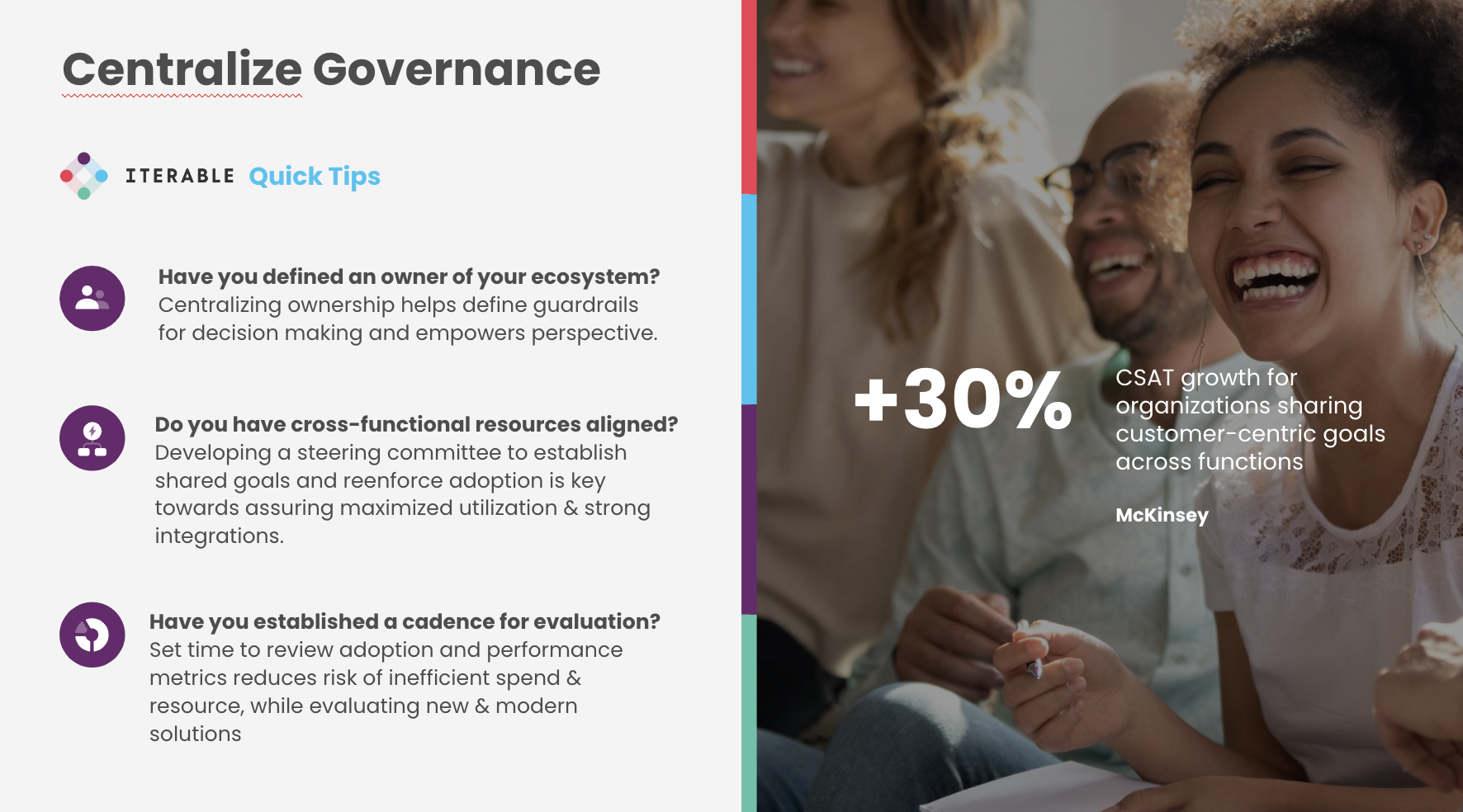We all know someone with their entire coffee table covered in remote controls (one for the Roku, the TV, the speakers, the gaming console, etc.)—each of them having pretty much the same buttons. But, as you reach for one to raise the volume, you’re swiftly met with an explanation of why it’s the wrong one to use. Sure, they all can control the volume but this one happens to control the surround sound too.
Think of each remote on the coffee table as a tool in your martech stack. These remote controls have some overlapping capabilities, but they all have unique capabilities too. It’s messy and confusing and can quickly start a family argument. (Okay, maybe that last point isn’t applicable to your martech stack, but the rest of the metaphor is solid.)
Having a variety of tools in your martech stack is absolutely beneficial—according to ChiefMartec, enterprise brands use 120 marketing tools, on average—but, with the expanding capabilities of the existing tools on the market, it’s likely there are redundancies that are causing inefficiencies—not to mention costing a pretty penny.
Consolidating is Crucial
Besides reducing confusion and friction in the marketing process—which can trickle down and impact the customer experience—consolidating your martech stack has other perks.
- Reducing or Eliminating Redundancies. We touched on it a bit, but having multiple tools that can execute the same tasks can cause duplicate work and inefficient marketing practices. Plus, the costs can add up. According to Bain, 30% to 40% of cost savings come from fundamentally rethinking and reengineering technology.
-
Maximizing Return on Investment. If you’re already paying for a tool, why would you pay for another tool that does the exact same thing just because of an additional feature? Have you explored all of the features in your existing tools?
There are probably ways to use individual tools to their fullest potential without needing to add new tools to your stack. Marketers report using only 42% of the breadth of capabilities available in their martech stack overall, down from 58% in 2020, according to a new survey by Gartner.
-
Scaling Impact. A snowball can turn into an avalanche if your business continues to grow without organizing your stack. Too many tools quickly can become unwieldy. Consolidation can help prep your brand to scale and save your team time in the future.
Consolidation is key—everyone can appreciate a universal remote—but you can’t just start hacking tools out of your martech stack without understanding how it’s built. You first have to look inward to understand what you’re working with.
Understanding a MarTech Stack Audit
Auditing sounds scary and official, but really it’s just examining what capabilities and platforms are in your martech stack and how they’re all connected. This way if you do decide to consolidate you’ll know the impact it will have. This layout of tool connections and the way your martech stack is built is often referred to as the martech stack architecture.
Diving Into MarTech Stack Architecture
Martech stacks generally have some key ingredients that you’ll find across industries. We’re talking about a customer data activation platform, a data management platform, a journey orchestration platform, etc.


An example of how to think about martech stack architecture. Data is the foundation and the rest of the stack is layered on.
When thinking about your martech stack architecture, there’s one golden rule to keep in mind: consider your use case. You have to start with a basic set of tools that allows you to execute your business’ most important use case—these tools can be qualified as just the cost of doing business. Once you’ve established the basics you can layer on other tools.
This is where you need to be vigilant and evaluate each new tool and its capabilities to make sure it’s helping you achieve your business goals. There likely will be some redundancies as you begin to layer. You may have two customer data platforms (CDPs) in your stack, for example, but if their individual capabilities are uniquely important to your use case, you can prioritize them both in your stack.
A martech stack audit can help you determine which tools need to be part of your stack and which don’t.
Embarking on a MarTech Stack Audit
We specifically chose the word “embarking” because a martech stack audit is a journey. Tools alone don’t deliver results, it requires strategic orchestration, governance, and oversight to maximize return for your organization.
Taking Inventory
Like you’d do in any stock room, to understand what you have and what you need, you have to start by taking inventory. Be sure to document this process in depth so you can refer back to it as you continue on your consolidation journey.
Mike Braund, Iterable’s Senior Director of Marketing Operations, recommends creating a spreadsheet to take inventory and align tools to use cases. Your spreadsheet could have a column for the platform, what it does, what use case it supports, what it integrates with, pricing, point of contact, and when it renews. Have your team complete this exercise too, then compare. See where there’s overlap, where there are gaps, and review how each member is using the tools.


Example of martech stack audit documentation.
You’ll likely note the redundancies in this phase of consolidation. Are there different versions of the same information? Which is the easiest for your team to access and why? Would removing any of these tools impede your team’s ability to execute the necessary use case?
Centralizing Governance
You also need to create a centralized way to manage all of the different tools, capabilities, and team needs. Someone needs to own each environment you’re working in so you can get decisions made quickly. For example, if your goal is to create cross-channel journeys the technology may start to fade into a gray area between customer success management and martech. Have someone on the customer success (CS) team audit the tools they use and act as a liaison for their team.
Once these various team leads have been appointed, you can create a steering committee—a group that helps offer insight and resources as well as creates buy-in and team-wide adoption of tools.


Some Iterable Quick Tips to get started on centralizing governance.
Be sure to develop a regular cadence at which your steering committee connects to look over metrics, performance, and discuss any problems that may arise as you start to better understand the variety of tools in your stack.
Like we said, this is going to take time. To move forward you have to fully understand your martech stack as it stands.
We’re Just Getting Started
A martech stack audit will have different results for everyone. Based on use cases, martech stack architecture will look different for every brand. That’s why it’s important to remember this is only the beginning of the tech consolidation process.
After looking inward and understanding what your martech stack looks like, you have to look outward and understand the landscape of what’s available and what your martech stack really needs. Once you’ve explored options, then it’s time to plan for the future, look forward, and think about an integration or migration to make your martech stack as efficient as possible.
For a quick guide through the initial steps of consolidation and maximizing your martech stack value, be sure to check out our downloadable checklist.































